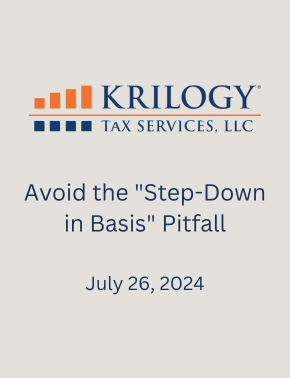 A commonly known provision of the tax code is the step-up in basis rule; many taxpayers encounter this when inheriting appreciated assets. A lesser-known and tricky related provision is the step-down rule, which can be a potential hazard causing losses to remain unrealized. This, in turn, leads to possible tax savings disappearing into thin air.
A commonly known provision of the tax code is the step-up in basis rule; many taxpayers encounter this when inheriting appreciated assets. A lesser-known and tricky related provision is the step-down rule, which can be a potential hazard causing losses to remain unrealized. This, in turn, leads to possible tax savings disappearing into thin air.
As background, the IRS allows for an adjustment of basis to the value of certain assets to their fair market value at the time of inheritance. When someone inherits an asset, such as real estate or marketable securities, the value of the asset for tax purposes is “stepped-up” or “stepped-down” to its current market value at the time of the original owner’s death. This means that the beneficiary of the inherited asset receives it with a new cost basis equal to its value at the time of inheritance, rather than the original cost basis of the deceased person. Then, when the beneficiary later sells the inherited asset, they would only owe capital gains tax on any increase in value that occurs after the date of inheritance, rather than on the entire increase since the original purchase by the deceased person. This can result in substantial tax savings for heirs, particularly for assets that have significantly appreciated over time. Therefore, some appreciated assets might be better to hold onto until death to provide a better tax outcome for your beneficiaries.
Generally, investors hope for a continued increase in value, but unfortunately, this is not always the case; there are circumstances where the lesser-known “step-down” in basis would occur. This happens when an asset has lost value between the time it was purchased and the date of the original owner’s death. As stated above, upon death assets are adjusted to their fair market value as of the date of death of the original owner. If an investment has decreased in value the asset will receive a reduction in basis instead of the typical step up in basis. When the asset is acquired, the beneficiary would acquire it with the lower fair market value as the basis, which results in a disadvantageous tax situation where the family essentially loses these losses upon inheritance.
However, if a taxpayer is in failing health, there are opportunities to make sure that any unrealized losses from the step-down rule can be realized or avoided outright. Each situation is different and requires a holistic view of the taxpayer’s financial picture, as well as that of a spouse or any prospective heirs, but potential tax-saving strategies might include selling or gifting the depreciated assets before death to make sure that the losses are realized and not lost. It’s important to note there are exceptions and limitations to these rules. Additionally, the step-up and step-down rules do not apply to inherited retirement accounts such as IRAs and 401(k)s.
End-of-life planning can be a difficult topic and tax laws can be complex, and each circumstance presents unique pitfalls and opportunities. When it’s needed, time is of the essence; waiting too long might leave tax savings on the table. Reach out to your trusted Krilogy Tax team for guidance specific to your situation.
Krilogy® does not provide tax and legal advice. Krilogy® is affiliated with Krilogy Tax Services, LLC. Krilogy® Tax Services provides tax planning and preparation services for an additional cost to Krilogy® clients. You should consult your attorney or qualified tax advisor regarding your situation.













